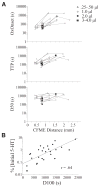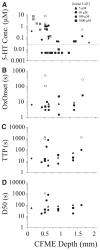Serotonin concentrations in the lumbosacral spinal cord of the adult rat following microinjection or dorsal surface application
- PMID: 17634342
- PMCID: PMC2668515
- DOI: 10.1152/jn.00309.2007
Serotonin concentrations in the lumbosacral spinal cord of the adult rat following microinjection or dorsal surface application
Abstract
Application of neuroactive substances, including monoamines, is common in studies examining the spinal mechanisms of sensation and behavior. However, affected regions and time courses of transmitter activity are uncertain. We measured the spatial and temporal distribution of serotonin [5-hydroxytryptamine (5-HT)] in the lumbosacral spinal cord of halothane-anesthetized adult rats, following its intraspinal microinjection or surface application. Carbon fiber microelectrodes (CFMEs) were positioned at various locations in the spinal cord and oxidation currents corresponding to extracellular 5-HT were measured by fast cyclic voltammetry. Intraspinal microinjection of 5-HT (100 microM, 1-3 microl) produced responses that were most pronounced at CFMEs positioned <or=800 microm from the drug micropipette: 5-HT concentration was significantly higher (1.43 vs. <0.28% of initial concentration) and response latency was shorter (67.1 vs. 598.2 s) compared with more distantly positioned CFMEs. Treatment with the selective 5-HT reuptake inhibitor clomipramine only slightly affected the spread of microinjected 5-HT. Surface application over several segments led to a transient rise in concentration that was usually apparent within 30 s and was dramatically attenuated with increasing depth: 0.25% of initial concentration (1 mM) within 400 microm of the dorsal surface and <0.001% between 1,170 and 2,000 microm. This initial response to superfusion was sometimes followed by a gradual increase to a new concentration plateau. In sum, compared with bath application, microinjection can deliver about tenfold higher transmitter concentrations, but to much more restricted areas of the spinal cord.
Figures







Similar articles
-
Serotonin potentiates sympathetic responses evoked by spinal NMDA.J Physiol. 2006 Dec 1;577(Pt 2):525-37. doi: 10.1113/jphysiol.2006.116574. Epub 2006 Sep 14. J Physiol. 2006. PMID: 16973701 Free PMC article.
-
Differential pulse voltammetry in the dorsal horn of the spinal cord of the anesthetized rat: are the voltammograms related to 5-HT and/or to 5-HIAA?Brain Res. 1983 Sep 26;275(2):311-9. doi: 10.1016/0006-8993(83)90992-7. Brain Res. 1983. PMID: 6194856
-
Spinal 5-HT pathways and the antinociception induced by intramedullary clonidine in rats.Naunyn Schmiedebergs Arch Pharmacol. 1992 Sep;346(3):333-8. doi: 10.1007/BF00173548. Naunyn Schmiedebergs Arch Pharmacol. 1992. PMID: 1407017
-
Circling behavior induced by microinjection of serotonin reuptake inhibitors in the substantia nigra.Pharmacol Biochem Behav. 2002 Jan-Feb;71(1-2):353-63. doi: 10.1016/s0091-3057(01)00721-3. Pharmacol Biochem Behav. 2002. PMID: 11812544
-
Spatial and temporal patterns of serotonin release in the rat's lumbar spinal cord following electrical stimulation of the nucleus raphe magnus.Neuroscience. 2006 Oct 27;142(3):893-903. doi: 10.1016/j.neuroscience.2006.06.038. Epub 2006 Aug 4. Neuroscience. 2006. PMID: 16890366 Free PMC article.
Cited by
-
Neuromodulation and Synaptic Plasticity for the Control of Fast Periodic Movement: Energy Efficiency in Coupled Compliant Joints via PCA.Front Neurorobot. 2016 Mar 8;10:2. doi: 10.3389/fnbot.2016.00002. eCollection 2016. Front Neurorobot. 2016. PMID: 27014051 Free PMC article.
-
Monoamine Release in the Cat Lumbar Spinal Cord during Fictive Locomotion Evoked by the Mesencephalic Locomotor Region.Front Neural Circuits. 2017 Aug 30;11:59. doi: 10.3389/fncir.2017.00059. eCollection 2017. Front Neural Circuits. 2017. PMID: 28912689 Free PMC article.
-
Monoaminergic control of spinal locomotor networks in SOD1G93A newborn mice.Front Neural Circuits. 2014 Jul 4;8:77. doi: 10.3389/fncir.2014.00077. eCollection 2014. Front Neural Circuits. 2014. PMID: 25071458 Free PMC article.
-
Potential for Cell-Transplant Therapy with Human Neuronal Precursors to Treat Neuropathic Pain in Models of PNS and CNS Injury: Comparison of hNT2.17 and hNT2.19 Cell Lines.Pain Res Treat. 2012;2012:356412. doi: 10.1155/2012/356412. Epub 2012 Apr 24. Pain Res Treat. 2012. PMID: 22619713 Free PMC article.
-
V3 spinal neurons establish a robust and balanced locomotor rhythm during walking.Neuron. 2008 Oct 9;60(1):84-96. doi: 10.1016/j.neuron.2008.09.027. Neuron. 2008. PMID: 18940590 Free PMC article.
References
-
- Antri M, Orsal D, Barthe J-Y. Locomotor recovery in the chronic spinal rat: effects of long-term treatment with a 5-HT2 agonist. Eur J Neurosci. 2002;16:467– 476. - PubMed
-
- Armstrong-James M, Millar J. High-speed cyclic voltammetry and unit recording with carbon fibre microelectrodes. In: Marsden CA, editor. Measurement of Neurotransmitter Release In Vivo. Toronto: Wiley; 1984. pp. 209–226.
-
- Barbeau H, Rossignol S. Initiation and modulation of the locomotor pattern in the adult chronic spinal cat by noradrenergic, serotonergic, and dopaminergic drugs. Brain Res. 1991;546:250–260. - PubMed
-
- Bardin L, Bardin M, Lavarenne J, Eschalier A. Effect of intrathecal serotonin on nociception in rats: influence of the pain test used. Exp Brain Res. 1997;113:81– 87. - PubMed
-
- Binns BC, Huang Y, Goettl VM, Hackshaw KV, Stephens RL. Glutamate uptake is attenuated in spinal deep dorsal and ventral horn in the rat spinal nerve ligation model. Brain Res. 2005;1041:38– 47. - PubMed
Publication types
MeSH terms
Substances
Grants and funding
LinkOut - more resources
Full Text Sources

